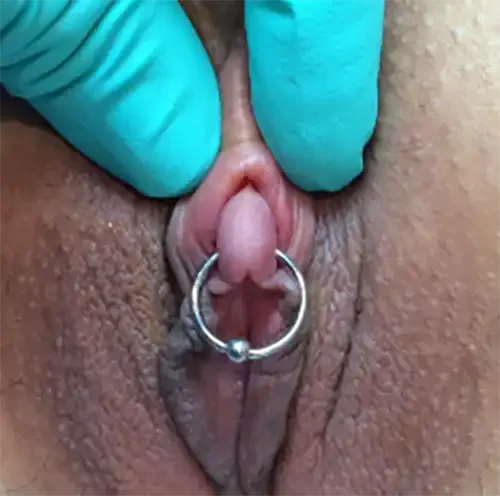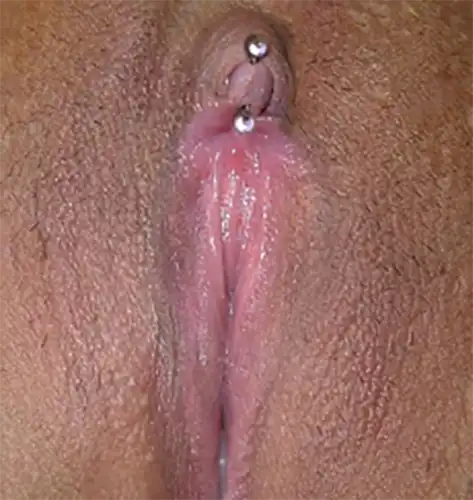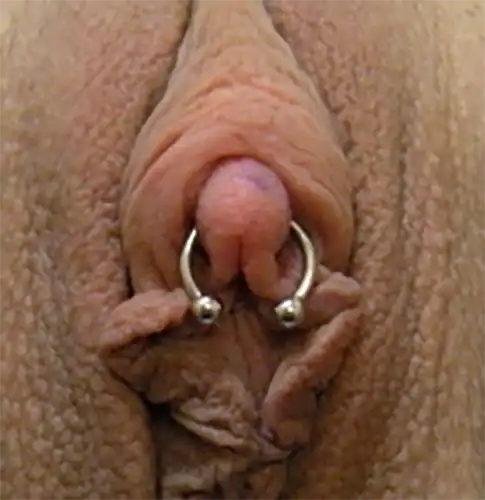Clitoris Piercing in Nairobi, Kenya
Clitoris piercing is a type of body modification involving the insertion of jewelry into or around the clitoris. This procedure is often chosen for aesthetic, cultural, or sexual reasons.

Clitoris Piercing
Types of Clitoris Piercing
- Vertical Clitoral Hood (VCH) Piercing: The most common type, this piercing goes through the clitoral hood vertically above the clitoris. It is typically chosen because it can enhance sexual stimulation.
- Horizontal Clitoral Hood (HCH) Piercing: This piercing goes through the clitoral hood horizontally. It is also primarily chosen for its potential to enhance sexual pleasure.
- Clitoral Glans Piercing: This is less common and involves piercing directly through the clitoral glans. Due to its complexity and potential for complications, it requires a highly experienced piercer.
Clitoris Piercing Procedure
The clitoris piercing procedure, especially for the more common clitoral hood piercings (VCH and HCH), is a delicate process that requires precision and expertise. Here’s a detailed overview of what the procedure typically involves:
- Consultation:
– Discussion: Our piercer will discuss the different types of clitoral piercings, assess your anatomy to determine suitability, and explain the potential risks and aftercare requirements.
– Health Check: You may be asked about your medical history to ensure you’re a good candidate for the piercing. This includes any history of keloids, allergies to metals, or other health concerns.
– Consent: You’ll be required to provide informed consent, understanding the risks and aftercare involved. - Choosing Jewelry: Our piercer will help you select appropriate jewelry made from hypoallergenic materials such as surgical steel, titanium, or niobium. Initial jewelry often includes curved barbells or captive bead rings.
The Procedure
- Sanitization: Our piercer will sanitize their hands and wear gloves. The piercing area will be thoroughly cleaned with an antiseptic solution to minimize infection risk.
- Marking: Using a sterile surgical marker, our piercer will mark the entry and exit points for the piercing. This step ensures precision in placement.
- Positioning: You will be asked to lie down in a comfortable position that provides our piercer with the best access to the area.
- Clamping (if necessary): For VCH piercings, a clamp might be used to hold the hood tissue in place and ensure accuracy. The clamp minimizes movement and pain.
- Piercing: Using a single-use, sterilized needle, our piercer will quickly and accurately create the piercing. The needle will be inserted through the marked entry and exit points.
- Inserting Jewelry: Immediately after the piercing, our piercer will insert the chosen jewelry through the new hole. This is often done swiftly to reduce discomfort.
- Cleaning: The area will be cleaned again to remove any blood and to ensure the jewelry is correctly positioned.
Post-Procedure Care
- Cleaning:
– The area should be cleaned with a saline solution twice daily to prevent infection.
– Avoid using harsh soaps or alcohol-based products that can irritate the piercing. - Healing Time:
– Initial healing usually takes about 4 to 8 weeks, but full healing can take several months.
– It’s essential to avoid sexual activity, swimming, or any activity that could introduce bacteria to the area during the initial healing phase. - Monitoring for Complications:
– Watch for signs of infection, such as excessive redness, swelling, discharge, or pain.
– If any complications arise, seek medical advice promptly. - Jewelry Changes: Avoid changing the jewelry until the piercing is fully healed. Consult your piercer if you feel a change is necessary.
Considerations before getting a Clitoris Piercing
Before deciding to get a clitoris piercing, there are several important considerations to take into account to ensure that it is the right choice for you. Here are key factors to consider:
Health and Anatomy
- Anatomical Suitability: Not everyone’s anatomy is suitable for a clitoris or clitoral hood piercing. At Rebel Inks Tattoos, Tattoo Removal, and Body Piercings Parlour we have professional piercers who will assess your anatomy to ensure there is enough tissue to safely accommodate the piercing without causing damage or discomfort.
- Health Conditions: Certain health conditions, such as diabetes or blood disorders, may affect healing times or increase the risk of complications. Discuss any medical conditions with our piercer before proceeding.
- Allergies: Ensure you are not allergic to the materials commonly used for piercing jewelry, such as nickel. Opt for hypoallergenic materials like titanium or surgical steel.
Choosing a Professional Piercer
- Experience and Reputation: At Rebel Inks Tattoos, Tattoo Removal, and Body Piercings Parlour we have piercers with extensive experience in genital piercings. Look for reviews, ask for recommendations, and verify credentials.
- Hygiene Standards: At Rebel Inks Tattoos, Tattoo Removal, and Body Piercings Parlour, our studio follows strict hygiene protocols, including the use of sterilized equipment and single-use needles.
Pain and Healing
- Pain Tolerance: Understand that genital piercings can be more painful than other types of piercings due to the sensitivity of the area. Consider your pain tolerance and discuss pain management options with your piercer.
- Healing Time: Healing can take anywhere from 4 to 8 weeks. During this period, you’ll need to follow strict aftercare routines and avoid certain activities that could cause irritation or infection.
Aftercare Commitment
- Aftercare Routine: Be prepared to commit to a thorough aftercare routine, including regular cleaning with saline solution and avoiding irritants such as lotions, tight clothing, and sexual activity during the healing period.
- Potential Complications: Be aware of the signs of infection or other complications, such as excessive swelling, redness, discharge, or pain. Promptly seek medical advice if these symptoms occur.
Lifestyle Considerations
- Sexual Activity: Consider how the piercing might affect your sexual activity. You will need to abstain from sex during the initial healing period and be cautious afterward to avoid trauma to the piercing.
- Clothing Choices: Tight clothing can irritate the piercing during healing. Plan to wear loose-fitting clothing and breathable fabrics to minimize discomfort.
Personal and Psychological Factors
- Motivation: Reflect on your reasons for wanting the piercing. Whether it’s for aesthetic reasons, sexual enhancement, or personal empowerment, understanding your motivation can help ensure you’re making the decision for the right reasons.
- Body Image and Self-Esteem: Consider how the piercing might affect your body image and self-esteem. For many, it can be a positive and empowering choice, but it’s important to be confident and comfortable with the decision.
Financial Considerations
- Cost: Genital piercings can be more expensive than other types of piercings due to the skill required. Ensure you are prepared for the cost of the piercing and any follow-up care or jewelry changes.
- Insurance: Most health insurance plans do not cover body piercings or complications arising from them. Be prepared to cover any medical expenses out-of-pocket if complications occur.
Deciding to get a clitoris piercing is a personal choice that should be made after careful consideration of the factors outlined above. Ensuring you are informed and prepared will help you have a safe and positive experience. At Rebel Inks Tattoos, Tattoo Removal, and Body Piercings Parlour we have professional piercing providers to address any concerns or questions before proceeding.
Pain and Healing of Clitoris Piercing
Understanding the pain involved and the healing process is crucial for anyone considering a clitoris piercing. Here’s a detailed guide to help you know what to expect:
Pain During the Piercing Procedure
- Pain Level:
– Clitoris piercings, especially clitoral hood piercings (VCH or HCH), can be more painful than other types of piercings due to the high concentration of nerve endings in the genital area.
– The actual piercing procedure is very quick, typically lasting only a few seconds, which helps minimize the duration of pain. - Pain Management:
– At Rebel Inks Tattoos, Tattoo Removal, and Body Piercings Parlour our piercers often recommend breathing techniques or distraction methods to help manage pain during the procedure.
– Some piercers might use numbing creams, although these are not always effective and can sometimes interfere with the procedure.
Immediate Post-Piercing Sensations
- Initial Discomfort:
– Expect some throbbing, soreness, and sensitivity immediately after the piercing. This discomfort usually subsides within a few hours to a couple of days.
– Some individuals might experience a sharp or stinging sensation, which is normal and should diminish quickly. - Swelling and Redness: Mild swelling and redness around the pierced area are common in the first few days. This is part of the body’s natural healing response.
Healing Process
- Healing Time Frame: The average healing time for clitoral hood piercings (VCH or HCH) is typically 4 to 8 weeks. The exact duration can vary based on individual healing rates and adherence to aftercare routines.
- Stages of Healing:
– Initial Healing (First 1-2 weeks): The piercing site will begin to form a seal around the jewelry. Redness and swelling should decrease during this stage.
– Intermediate Healing (2-6 weeks): Tissue will continue to repair itself, and any initial discomfort should lessen significantly. Regular cleaning is crucial during this phase.
– Final Healing (6-8 weeks and beyond): The piercing should be mostly healed, with full tissue integrity restored. Sensitivity may persist for some individuals but should be manageable.
Clitoris Piercing Aftercare
Proper aftercare is crucial for the healing and health of a clitoris piercing. Adhering to the recommended aftercare routine helps prevent infections, reduces discomfort, and ensures a smooth healing process. Here’s a comprehensive guide to aftercare for a clitoris piercing:
Immediate Aftercare
- Initial Cleaning:
– Clean the piercing with a sterile saline solution or a saline wound wash within the first few hours after getting pierced.
– Avoid using alcohol, hydrogen peroxide, or any harsh antiseptics as these can irritate the piercing. - Pain and Swelling: Apply a cold compress to reduce swelling and alleviate initial pain. Ensure the compress is clean and do not apply it directly to the piercing—use a clean cloth as a barrier.
Daily Cleaning Routine
- Saline Solution Soaks:
– Soak the piercing in a saline solution twice daily. You can do this by using a saline wound wash spray or by dipping a clean gauze pad in saline and holding it against the piercing.
– Alternatively, you can make a saline solution at home by dissolving 1/4 teaspoon of non-iodized sea salt in 8 ounces of warm distilled water. - Cleaning Technique:
– Gently clean around the piercing with a saline solution-soaked gauze pad or cotton swab. Avoid rotating or twisting the jewelry, as this can cause irritation and delay healing.
– After cleaning, pat the area dry with a clean, disposable paper towel. Avoid using cloth towels that can harbor bacteria.
General Hygiene Practices
- Hand Washing: Always wash your hands thoroughly with soap and water before touching your piercing to avoid introducing bacteria to the area.
- Avoid Submersion: Do not submerge the piercing in pools, hot tubs, lakes, or bathtubs to reduce the risk of infection. Showers are generally safer than baths during the healing period.
- Clothing: Wear loose, breathable clothing and cotton underwear to minimize friction and irritation. Avoid tight clothing that can rub against the piercing.
Sexual Activity
- Abstinence: Refrain from sexual activity for at least the first few weeks to allow the initial healing to take place without disturbance.
- Protection:
– When you resume sexual activity, use protection such as condoms or dental dams to minimize contact and prevent the introduction of bacteria to the area.
– Be gentle and mindful of the piercing to avoid trauma.
Monitoring and Managing Issues
- Infection Signs: Watch for signs of infection, including excessive redness, swelling, pain, heat, and unusual discharge. If you notice any of these symptoms, contact your piercer or a healthcare provider immediately.
- Jewelry Issues: If you experience any problems with the jewelry, such as discomfort, rejection, or migration, consult your piercer. Do not attempt to change the jewelry yourself until the piercing is fully healed.
Long-term Care
- Jewelry Changes: Only change the jewelry after the piercing is fully healed, which usually takes about 4 to 8 weeks. Have a professional piercer perform the first jewelry change to ensure it’s done safely.
- Ongoing Hygiene: Even after the piercing has healed, maintain good hygiene and clean the area regularly to prevent buildup of dead skin cells and other debris.
What to Avoid
- Irritants:
– Avoid using lotions, perfumes, or other products near the piercing site during the healing period.
– Stay away from antibacterial ointments or creams, as they can block air circulation and slow down the healing process.
Proper aftercare is essential for the healing and maintenance of a clitoris piercing. By following these guidelines and being attentive to your body’s signals, you can ensure a smooth and healthy healing process.
Clitoris Piercing Jewelry
Choosing the right jewelry for a clitoris piercing, particularly clitoral hood piercings (VCH or HCH), is crucial for comfort, safety, and aesthetics. Here’s an overview of the best practices and options for clitoris piercing jewelry:
Types of Jewelry
- Curved Barbells:
– Commonly used for VCH piercings.
– The curved shape sits comfortably against the anatomy and reduces pressure on the piercing. - Captive Bead Rings (CBRs):
– Suitable for both VCH and HCH piercings.
– Features a ball that locks into place, offering a secure fit.
– The circular shape allows for some movement and flexibility. - Straight Barbells:
– Sometimes used for VCH piercings.
– Less common than curved barbells, but can be suitable depending on individual anatomy and preference.
Material Considerations
- Surgical Steel:
– Hypoallergenic and commonly used for initial piercings.
– Make sure it’s implant-grade (316L or 316LVM) to avoid allergic reactions. - Titanium:
– Lightweight, hypoallergenic, and highly recommended for those with metal sensitivities.
– Titanium is less likely to cause allergic reactions and is ideal for initial healing. - Niobium:
– Another hypoallergenic option that is safe for those with metal sensitivities.
– Available in a variety of colors, which can be achieved through anodizing. - Gold:
– Only use solid 14k or 18k gold to ensure safety and avoid irritation.
– Gold-plated or gold-filled jewelry should be avoided as the plating can wear off and expose the base metal.
Size and Fit
- Gauge:
– The thickness of the jewelry. For clitoral hood piercings, 14 gauge (1.6 mm) or 16 gauge (1.2 mm) are commonly used.
– Thicker gauges are less likely to migrate or tear but discuss with your piercer to choose the appropriate gauge for your anatomy. - Length/Diameter:
– The length of a barbell or the diameter of a ring should be chosen based on your anatomy to ensure a comfortable fit.
– Proper sizing is crucial to avoid unnecessary pressure and facilitate healing.
Jewelry Selection Tips
- Professional Advice: Always get your jewelry from a reputable piercing studio. Your piercer will measure and recommend the appropriate size and type of jewelry based on your anatomy.
- Quality Over Aesthetics: Prioritize high-quality materials over decorative elements, especially during the initial healing period. Fancy designs can be used once the piercing is fully healed.
- Avoid Cheap Materials: Avoid jewelry made from materials like silver, as they can tarnish and cause irritation or infection.
Changing Jewelry
- Healing Time: Wait until the piercing is fully healed (typically 4 to 8 weeks) before changing the jewelry. Consult your piercer if you are unsure about the healing status.
- Professional Change: Have a professional piercer change the jewelry for the first time to ensure it is done safely and correctly.
Aftercare for Jewelry
- Regular Cleaning: Clean the jewelry and the pierced area with a saline solution regularly, even after the piercing is healed, to maintain hygiene.
- Monitor for Allergic Reactions: If you notice any signs of an allergic reaction (redness, itching, swelling), switch to a hypoallergenic material and consult your piercer.
Choosing the right jewelry for a clitoris piercing involves considering the type, material, and size that best suits your anatomy and preferences. Prioritizing high-quality materials and proper fit will ensure a comfortable and safe healing process.
Cost of a Clitoris Piercing in Nairobi, Kenya
The cost of a clitoris piercing can vary widely depending on several factors, including the piercer’s experience, the studio’s location, and the quality of the jewelry used. Here’s a breakdown of what to expect when budgeting for a clitoris piercing:
Factors Influencing the Cost
- Piercer’s Experience and Reputation: More experienced and reputable piercers tend to charge higher fees due to their expertise and the quality of their work. This is especially important for genital piercings, which require a high level of skill.
- Geographic Location: Piercing studios in different areas may have varying price ranges. Rebel Inks Tattoos, Tattoo Removal, and Body Piercings Parlour is located in the heart of the Central Business Disrict (CBD) in Nairobi, Kenya, and is easily accessible to both locals and foreigners in the country
- Jewelry Quality: The type of jewelry used can greatly affect the overall cost. High-quality materials such as titanium, niobium, or solid gold are more expensive than lower-grade options but are recommended to ensure safety and reduce the risk of allergic reactions.
- Additional Services: At Rebel Inks Tattoos, Tattoo Removal, and Body Piercings Parlour we may include additional services or aftercare products in the overall cost of the piercing, such as consultation fees, numbing agents, or specialized aftercare solutions. Be sure to inquire about any additional fees or services when scheduling your appointment.
Average Cost Breakdown
- Initial Piercing Fee: The piercing fee typically covers the cost of the procedure itself, including the piercer’s time, expertise, and use of sterile equipment. This fee can vary widely depending on the studio and location.
- Jewelry Cost:
– Basic jewelry made from surgical steel might start at around.
– Higher-quality jewelry made from titanium, niobium, or solid gold can range from Ksh. to Ksh. or more. - Total Cost:
– Combining the piercing fee and the cost of high-quality jewelry, you can expect to pay anywhere from Ksh. to Ksh. in total.
– For a more premium experience with top-tier jewelry, the total cost might be on the higher end, around Ksh. to Ksh.
Clitoral Piercing Estimated Cost Breakdown Table
Component / Service | Estimated Cost (KSh) | Details / Notes |
Basic procedure + standard jewelry | 4,000 | Based on VCH/HCH or Princess Diana piercing prices |
Premium jewelry upgrade (implant-grade titanium/gold) | 1,000–2,500 | For hypoallergenic or decorative options |
Consultation & anatomical assessment | Included or 500 | Ensures suitability and safety |
Aftercare supplies (sterile saline, cleaning sprays) | 500–1,000 | Critical for healing in intimate areas |
Follow-up or check-up visits | 200–500 | Optional per studio policy |
Total (Basic Package) | 4,000–4,500 | Procedure plus base jewelry and minimal inclusions |
All-Inclusive Package (Upgrades + Full Support) | 6,000–8,500 | Includes premium jewelry and aftercare essentials |
Tips for Budgeting
- Research and Compare: Look up multiple studios in your area and compare prices, but prioritize reputation and cleanliness over cost alone. Online reviews and word-of-mouth recommendations can be very helpful.
- Consultations: Schedule consultations with a few piercers to discuss their experience, the procedure, and aftercare. This can also give you a better idea of the total cost and what it includes.
- Aftercare Products: Don’t forget to budget for aftercare products such as saline solution or wound wash, which are essential for proper healing.
- Avoid Bargain Deals: Be wary of studios offering significantly lower prices than the average. Quality and safety should be your top priorities, and very low prices might indicate a compromise on hygiene standards or experience.


Possible side effects of Clitoris Piercing
A clitoris piercing, like any body modification, comes with potential side effects and risks. It’s essential to be aware of these possibilities before undergoing the procedure to make an informed decision and to know what to watch for during the healing process. Here are the possible side effects and complications associated with clitoris piercing:
Immediate Side Effects
- Pain and Discomfort: Pain and discomfort are common immediately following the procedure. This is typically localized and should subside within a few days.
- Swelling and Redness: Mild swelling and redness around the pierced area are normal and should decrease within a week.
- Bleeding: Minor bleeding can occur during and shortly after the piercing. This usually stops within a few hours.
Short-Term Complications
- Infection: The risk of infection is higher with genital piercings due to the area’s proximity to bodily fluids. Signs include excessive redness, swelling, heat, pain, and unusual discharge. Proper aftercare is crucial to prevent infection.
- Allergic Reactions: Allergic reactions can occur if the jewelry contains nickel or other irritants. Symptoms include itching, redness, and rash around the piercing.
- Jewelry Rejection or Migration: The body may push the jewelry out, causing it to migrate or be expelled. This can happen if the jewelry is not suitable for your anatomy or if the piercing is not properly cared for.
- Nerve Damage: Improper piercing technique can damage nerve endings, leading to numbness, loss of sensation, or chronic pain. Choosing an experienced piercer reduces this risk.
Long-Term Complications
- Scarring: Scar tissue can form around the piercing, especially if the area is traumatized during healing or if an infection occurs. Hypertrophic scarring or keloids can develop in some individuals.
- Persistent Pain or Discomfort: Some individuals may experience ongoing pain or discomfort long after the initial healing period. This could be due to nerve damage or improper healing.
- Changes in Sensation: Changes in sexual sensation, either increased or decreased, can occur. While some individuals seek this piercing for enhanced stimulation, others might experience reduced sensitivity.
- Difficulty with Certain Activities: Certain activities, including sexual intercourse, exercise, or wearing tight clothing, may become uncomfortable or painful during the healing period and, in some cases, even after healing.
While clitoris piercings can be an exciting and rewarding form of body modification, they come with potential side effects and risks that should not be taken lightly. Being informed about these risks and knowing how to manage them is crucial for a successful piercing experience. Always consult with a professional piercer and follow their aftercare instructions diligently to minimize complications.
Get In Touch
For more information on the list above and any other special services,please call or come in for free consultation
Testimonials
After he pierced my industrial piercing and seeing his amazing work, I feel even more excited about getting my tattoo with him in January. I’m really looking forward to it!
I am extremely happy with my new 'Safari' tattoo from Eric at Rebel Inks! The quality of the artwork is fantastic. Eric is a true professional and an amazing artist.
The preparation and design process was thorough and collaborative. He was very patient with my specific requests, including making sure all the elements, which hold personal meaning, were perfect.
The service was friendly and highly professional from start to finish. Despite the 8-hour session, Eric was a pleasant person to spend the time with.
The aftercare guidance and follow-up have been excellent and careful, which has made the healing process easy and better than expected.
I highly recommend Eric for anyone looking for a thoughtful, talented, and caring tattoo artist.
I recommend them 💯
I would definitely recommend if you’re thinking of getting a piercing!
The staff were super friendly, explained everything clearly, and made me feel so at ease. They answered all my nervous questions (and I had many questions),
They walked me through the whole process, gave detailed aftercare instructions, and even followed up afterward to check how I was healing 🫶
Clean, professional, and full of good vibes.
Would 100% recommend . Definitely making a second trip here.
This was the second tattoo I got and I wish I could have come to Eric for my first one! He gave me really great after-care directions for the tattoo as well as a little jar of his own Vaseline-type stuff to put over my tattoo while it was healing! He even put second skin over my tattoo so that I didn’t have to worry about it for the first few days. Now THAT’S good service. My first tattoo artist didn’t do none of that lol.
After the session Eric didn’t rush me and my friend out, he chatted with us and even when he found out I was an artist too— really encouraged me to keep creating and to find a community of artists to support me. I almost cried because I’ve had such a hard time with my own art the past couple of years, it meant so much to me to have a fellow very talented artist say that to me. 🤍🤍🤍
Eric you’re amazing, don’t ever stop creating and just know you’ve impacted lives all over the world!🫶🏻 thanks so much for everything!!
From the moment I walked in, Eric was professional, welcoming, and attentive. He made sure I was comfortable throughout, provided everything I needed, and explained every step of the process. The tattooing itself was unbelievably smooth - I genuinely felt no pain compared to my previous tattoos over the last 22 years.
Eric also gave me excellent aftercare guidance and products, and thanks to that, my tattoo healed beautifully. The attention to detail, precision, and shading are absolutely stunning. This is hands-down the best tattoo I've ever had, and I will be flying back to Nairobi for any future ink.
If you want incredible art, a professional experience, and a talented artist who truly cares about his clients, Rebel Ink is the place to go!
From start to finish, the service was exceptional. The piercer was professional, knowledgeable, and made me feel completely comfortable. The cleanliness of the place was above and beyond — everything was spotless and hygienic, which really put me at ease. Highly recommend for anyone considering a piercing!
Shout out to Eric😘
We ended up changing the jewelry three times to ensure I had the best fit and avoided any signs of rejection, and he always listened to my suggestions as a client, which I really appreciated. Now, three months in, my piercing is healing beautifully, with no sign of rejection. Highly recommend for anyone who values a piercer who cares about your comfort and healing journey!
What stood out the most was the aftercare Eric checked in with me even three weeks later to see how the tattoo was healing. That kind of follow-up shows how much he truly cares about his work and his clients.
I’m very satisfied and will definitely be coming back for my next piece. Highly recommend!
The piercing wasn't as painful as I had thought and the process was quick and satisfactory. I love it!!!
The piercing is healing well thanks to the aftercare instructions and follow-up. I would highly recommend Rebel Inks
Eric also did a belly button piercing for a friend, guiding her through the process, doing the piercing and then explaining the after care to her.
The shop is on the 3rd floor, with the entrance to the stairs near an alleyway on the left. The shop is perfect size, clean, and attractive looking. The mural is pretty dope.
Thank you for the amazing service! 🔥👅✨
I got piercibgs there and the process was really good. My biggest concern was hygiene but that wasn't an issue at all, they use new needles and they sanitize them.
The service itself was also welcoming.
I was informes of everything i needed to know beforehand.
10/10 would recommend!
Eric was so calm and patient with my almost 2 year old lady. It was such a clean and hygienic process. We will definitely be back for our second rounds of piercings and maybe even another tattoo!
They assess the area before any art and advise one accordingly. They also give one post clean up process and also do a check up after the body art projects. Overall, I loved my experience and I’m hooked. 👍
Will definitely come back next time I’m in town 🙂
He listened to what I actually wanted and made sure he could fit in the time before I flew back home.
The shop is clean & private and is easy enough to find.
Eric has even checked in a couple of times since to make sure all is good.
I would totally recommend Eric! I absolutely love my Elephants!
I had a very easy healing period and always follow up from Eric to check on my progress...I would highly recommend if you are a first timer because from my experience all went very well and attention to detail
Thank you for a good job and looking forward to send all my friends your way
And all the best with the new year 2025!
From the moment I walked in, the staff was super friendly and made me feel at ease. The studio had a clean, professional atmosphere, which immediately put me at ease. My piercer was incredibly skilled and explained every step of the process, ensuring I was comfortable the entire time. The piercing was quick and practically painless, and the aftercare instructions were clear and easy to follow. I can tell they really care about the health and safety of their clients.
Overall, a fantastic experience—I highly recommend Rebel Inks and Tattoos for anyone looking to get pierced or tattooed!
They do follow up after their services
Eric's Studio isn’t just a place to get a tattoo—it’s an experience. The combination of professionalism, artistic talent, and a welcoming environment makes it a standout destination for anyone considering a tattoo.
I highly recommend Eric’s Studio to both first-timers and seasoned tattoo enthusiasts. If you’re looking for a high-quality tattoo and an enjoyable experience, this is the place to go.
I would definitely recommend their services again and again
Thank you Rebel Ink
My piercings are healing ❤️🩹 well
I would 💯 recommend
I will definitely come back for more .
Two, all the equipments he used for the piercings were new and/or sterilised.
Three, the parlour itself was very clean and was up to par with the hygiene standards.
Four, Eric provided effective aftercare instructions, making sure I knew exactly how to take care of my new piercings and he kept in touch and continues to do so, to check on the healing progress.
I highly highly highly recommend this place!!!
Would definitely recommend them to friends and go back for other piercings
Not only was the piercing process smooth, but he also provided thorough aftercare instructions, making sure I knew exactly how to take care of my new piercings. What really impressed me was that he keeps in touch to check on how the healing is progressing – a sign of true care for his clients.
The shop maintains a high standard of hygiene, and the atmosphere is welcoming and comfortable, which really added to the positive experience. I highly recommend this place to anyone looking for a professional and caring experience. I’ll definitely be coming back for any future piercings!
My appreciation for the excellent customer service I received. The follow-ups were prompt, and I truly appreciated the gentleness and professionalism throughout. Thank you!"
"Looking for professional eyebrow microshading removal? Look no further!"
The customer care is top tier 👌🏾👌🏾.
Wonderful place to get tattoos and piercings. 💯💯
Eric goes ahead to follow up on his clients progress and gives good advice each time I reach out to him.
I would recommend Reble tattoos anytime.
Good job bro we really appreciate.
Ohh and the price is very fair.
The environment was clean , procedure was sterile and the jewelry used are of the best quality.
He followed up with me during the healing process, he educated me on what I needed to do for my aftercare.
Eric is confident, skilled , experienced and the best piercer. Highly recommend Rebel inks.✨
Definitely recommend!
Great experience.
Eric definitely know what he is doing .
I got exactly what I wanted 2 tiny tats on the same finger .
He was kind and patient throughout the session.
Healing process has been good .
Aftercare services were given and regular checkups on the healing process were done.
I would 💯recommend.
Eric gave me the best reception as it was my first time there,and made me trust him all the way. I appreciate good services.
There services are also affordable not to forget 😊.
He was also invested in the aftercare and would ensure I follow the do's and don'ts in taking care of the tattoo and ensuring proper healing and maximum ink retention.
Would highly recommend Rebel Inks Tattoos.
Rebel Inks Tattoo offer the best,affordable and quality tattoo removal services.If you have unwanted ink,choose Rebel Inks Tattoo,they're the best of the best and the professionalism is a top notch.They ensure you're free from unwanted ink with their Laser Tattoo Removal Technology...
I did a Laser Tattoo Removal with them and i can attest they're the best....
Kudos Eric...
I highly recommend.
It was a generally good experience with good hygiene during the piercing process and has been a smooth healing process.... 10/10
tips. Highly recommend 👍🏽
100% recommendable.
I was particularly impressed with Eric's attention to hygiene. He thoroughly cleaned the room before I entered, sanitized all of the equipment he would be using, and changed gloves between each ear. This level of cleanliness gave me great confidence in his professionalism.
Eric's commitment to customer service did not end on the day of the piercing. He followed up with me regularly throughout the healing process to ensure that I was following the aftercare instructions and that my earlobes were healing properly.
I highly recommend Rebel Inks to anyone in Nairobi who is considering getting a piercing. Eric is a highly skilled and experienced piercer who takes great pride in his work.
So I Check all the boxes below and more:
Customer Care: ✔️
Professionalism : ✔️
Cleanliness ✔️
Price: ✔️
After care service ✔️
Thanks and good job, Eric
The place is neat and clean and the equipments he used were also fine standards. Really appreciate his following up with me on the healing 🤗
I WOULD HIGHLY RECOMMEND THEIR SERVICES to everyone. Actually what you see on their website is EXACTLY what you will get. Keep up the good work Rebel inks Tattoos.
The infection is now gone. I would definitely recommend!
Can recommend this place totally and would go back there anytime!
Thanks!
OUR LOCATION
Areas We Serve
NAIROBI
KIAMBU
KAJIADO
MACHAKOS
















































































































































































































